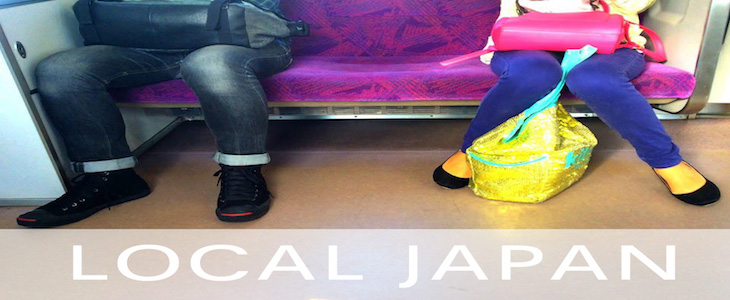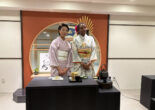
Local Japan – Kasukabe City has Big Things Going For It
Saitama prefecture, some decades ago, acquired an uncomplimentary nickname. A comedian dubbed the prefecture adjacent to Tokyo, Saitama, as “Daisaitama”, a portmanteau of “dasai” meaning uncool, and Saitama. The disparaging title implied that Saitama didn’t have much to offer in terms of sights and specialties. As local and international tourism has taken off in the last few years, Saitama’s profile has improved. The prefecture boasts historical and scenic places such as Chichibu and Kawagoe, and popular venues for concerts and events, and soon a major basketball arena in anticipation of the 2020 Summer Olympics.
 But it’s true that there are parts of Saitama that appear generically Tokyo, blandly suburban, and lacking in charm. As you whizz by on the trains, or merely skim the surface of “ekimae” or station front areas, you might see only same old, same old. But if you look a little closer, there are some amazing, charming and atmospheric places to explore.
But it’s true that there are parts of Saitama that appear generically Tokyo, blandly suburban, and lacking in charm. As you whizz by on the trains, or merely skim the surface of “ekimae” or station front areas, you might see only same old, same old. But if you look a little closer, there are some amazing, charming and atmospheric places to explore.
Over 15 years ago, I first visited one of these apparently nondescript suburban Saitama towns, Kasukabe City. My object was the Kasukabe Municipal Martial Arts Hall, a high-roofed and austere building with two regulation judo rings, and a spacious kendo hall, well used by local schools and community groups. Every Saturday afternoon for years, I practiced under the tutelage of a senior teacher with my local and international colleagues. When we finished training, we walked the 30 minutes back to the station, often taking time to talk over dinner at one of the many station front restaurants there.
Four things that struck me during those years of visiting Kasukabe City were right there in the front street, and were in fact, markers of the seasons. In late spring, the wisteria arbors, for which the front street Fuji Dori is named, hang heavy with blooms in April and May. In high summer, the blistering heat that is typical of Saitama made us move slowly to and from training, and we were sodden with perspiration in the dojo which was not air conditioned. In the fall, the great ginko tree at Kasukabe Station’s west exit made its presence, and its fertility, known littering the foot path with its pungent fruit. In winter, we bundled up with leg warmers, sweaters and hoodies under our training uniforms to keep our teeth from clattering in the bitter cold winds that howl across the flat landscape of southern Saitama Prefecture.
While I was a martial arts student merely traveling in to train, my view of Kasukabe City was rather narrow, limited to plodding from station to dojo, and the hanging out at the few izakaya which my colleagues had introduced me to. It wasn’t until I found myself commuting to and working in Kasukabe City a few years ago that I began to appreciate more of the city.
 In fact, Kasukabe City’s has some interesting Edo Period heritage. For some centuries, Kasukabe was a post town, a place of rest, on the way between the old capital Edo and Nikko, a pilgrimage destination. Today, Kasukabe has some preserved kura store houses just northwest of the central station, a handful of temples, and perhaps half a dozen historical sites including shrines and intangible cultural properties such as traditional lion dance rituals.
In fact, Kasukabe City’s has some interesting Edo Period heritage. For some centuries, Kasukabe was a post town, a place of rest, on the way between the old capital Edo and Nikko, a pilgrimage destination. Today, Kasukabe has some preserved kura store houses just northwest of the central station, a handful of temples, and perhaps half a dozen historical sites including shrines and intangible cultural properties such as traditional lion dance rituals.
At Kasukabe and Minamisakurai Stations, there are large display cases with traditional crafts such as straw hats, dolls and wooden furniture. While waiting on the platform, I got curious about the elegant carpentry on display – cabinets, boxes, and sword scabbards. I learned from my coworkers that these beautiful objects are significant cultural and commercial products of Kasukabe City. The story goes that artisans who worked on Nikko’s Toshogu, the shrine to Shogun Tokugawa Ieyasu, later settled in the area now known as Kasukabe and Saitama Cities and continued to work in kiri, or paulownia wood. Artisans in the region of Iwatsuki Castle specialized in dolls, and craftsmen south of there, in what is now Kasukabe, also used the same wood for their carpentry.
 The most impressive objects are perhaps the kiri-tansu. Kiri wood produces light weight lumber that is ideal for making tansu, classic Japanese chests of drawers and cabinets. Kiri wood expands in humid weather and contracts in dry conditions, so it is a good choice for storing and preserving textiles. Even better, it is flame-retardant. Kiri tansu cabinets made in Kasukabe are noted for their joinery which uses bamboo and wood dowels instead of nails. Kiri tansu are often simply finished, or lightly sealed with clay to bring out the attractive wood grain. The simple lines and light finish fit well with modern interiors. I kept my eyes peeled for one of these cabinets, and found many in local furniture shops. Such elegant craftsmanship comes at a price beyond my budget. However, many vintage kiri tansu come up for sale in recycle and antiques shops. Eventually I acquired a vintage three-section kiri tansu nearly as tall as I am. Because the kiri tansu is so light, I could easily disassemble and carry the tansu sections. This tall kiri tansu is now storage for nearly my entire wardrobe.
The most impressive objects are perhaps the kiri-tansu. Kiri wood produces light weight lumber that is ideal for making tansu, classic Japanese chests of drawers and cabinets. Kiri wood expands in humid weather and contracts in dry conditions, so it is a good choice for storing and preserving textiles. Even better, it is flame-retardant. Kiri tansu cabinets made in Kasukabe are noted for their joinery which uses bamboo and wood dowels instead of nails. Kiri tansu are often simply finished, or lightly sealed with clay to bring out the attractive wood grain. The simple lines and light finish fit well with modern interiors. I kept my eyes peeled for one of these cabinets, and found many in local furniture shops. Such elegant craftsmanship comes at a price beyond my budget. However, many vintage kiri tansu come up for sale in recycle and antiques shops. Eventually I acquired a vintage three-section kiri tansu nearly as tall as I am. Because the kiri tansu is so light, I could easily disassemble and carry the tansu sections. This tall kiri tansu is now storage for nearly my entire wardrobe.
The city has two other intangible traditions that are seasonal and easily overlooked if you don’t venture from the station front. From Kasukabe Station’s west exit for nearly two kilometers to Onuma Park, wisteria vines planted along the avenue burst into bloom every April and May. The wisteria trellises provide shade for cyclists and pedestrians, and there are many vantage points to take photos of the purple and white cascades of flowers. Kaskusabe is also home to Tokaen, a national treasure for its wisteria vines. The wisteria there are said to have been planted by Kobo Daishi, the founder of Shingon Buddhism, 1200 years ago.
 When you pass through stations on the Tobu Urban Park Line you might see large rectangular kites with red, green and white stripes on them. These are advertising for Kasukabe’s annual giant kite festival. Every year on May 3rd and 5th local community groups fly giant kites on the bank of the Edo River. All over Japan, kites fly to mark celebrations and religious festivals. Over time, the size of the kites at some kite festivals grew to enormous proportions. At Kasukabe, teams of up to 100 people heave on thick ropes to pull kites of up to 800 kilograms. When the kites are aloft, they’re breathtaking, and the team members can lean on the ropes and rely on the breeze to keep them up. However, launching kites of that size is harrowing, and crashes happen. It’s something like dropping a compact car from a five story building, with exploding parts in all directions. Needless to say, it’s exciting and dangerous.
When you pass through stations on the Tobu Urban Park Line you might see large rectangular kites with red, green and white stripes on them. These are advertising for Kasukabe’s annual giant kite festival. Every year on May 3rd and 5th local community groups fly giant kites on the bank of the Edo River. All over Japan, kites fly to mark celebrations and religious festivals. Over time, the size of the kites at some kite festivals grew to enormous proportions. At Kasukabe, teams of up to 100 people heave on thick ropes to pull kites of up to 800 kilograms. When the kites are aloft, they’re breathtaking, and the team members can lean on the ropes and rely on the breeze to keep them up. However, launching kites of that size is harrowing, and crashes happen. It’s something like dropping a compact car from a five story building, with exploding parts in all directions. Needless to say, it’s exciting and dangerous.
About four kilometers south of the kite flying grounds is another awesome giant spectacle that is hidden underground and has saved Tokyo from flooding for almost a decade. Looming over the Edo River is the pump building of the Tokyo Metropolitan Area Outer Underground Discharge Channel. The long title is abbreviated to G-CANS in English, and has the catchier title RyuQKan in Japanese. The pump building is impressive, but below it is a massive reservoir. The drill used to cut the reservoir tunnels is displayed in front of RyuQKan, and it gives a sense of just how enormous the project, and the reservoir, is. When not swallowing up river water, the reservoir is used for television and movie locations. Visitors can tour it, too.
 Back at Kasukabe’s main train station, you might see a Japanese pop culture icon and Kasukabe City’s native son. Emblazoned on billboards, and appearing as a mascot on products and souvenirs, is Crayon Shinchan. Crayon Shinchan began as a comic book character created by Kasukabe resident Usui Yoshito. Shinchan is a cheeky five year old boy whose antics solve as many problems as they cause. His goofy and sometimes ribald humor (and bared bums) makes Shinchan a funny and endearing character in comic books, movies, and animated television series. In honor of Shinchan, the local Ito-Yokado department store has periodically changed its roof top sign board to the parody version, “Sato Koko no Kado” under the bat logo. Shinchan and his mates attempt to do their civic duty through the activities of Kasukabe Boeitai, Kasukabe’s defense force. They don’t actually do much defending, but the zaniness of Crayon Shinchan puts Kasukabe City on the map.
Back at Kasukabe’s main train station, you might see a Japanese pop culture icon and Kasukabe City’s native son. Emblazoned on billboards, and appearing as a mascot on products and souvenirs, is Crayon Shinchan. Crayon Shinchan began as a comic book character created by Kasukabe resident Usui Yoshito. Shinchan is a cheeky five year old boy whose antics solve as many problems as they cause. His goofy and sometimes ribald humor (and bared bums) makes Shinchan a funny and endearing character in comic books, movies, and animated television series. In honor of Shinchan, the local Ito-Yokado department store has periodically changed its roof top sign board to the parody version, “Sato Koko no Kado” under the bat logo. Shinchan and his mates attempt to do their civic duty through the activities of Kasukabe Boeitai, Kasukabe’s defense force. They don’t actually do much defending, but the zaniness of Crayon Shinchan puts Kasukabe City on the map.
Kasukabe might appear to be a bit removed from Tokyo, but it is a convenient place to live and work. Kasukabe Station is served by two Tobu train lines that can whisk you to Kitasenju Station in as little as 20 minutes. The commutes can be relatively fast and tend not to be as crowded as some lines through other parts of Saitama and Tokyo. On my commute from neighboring Noda City to Kasukabe Station, there are always seats available.
It’s a convenient place for getaways, too. Tokyo Skytree is an easy trip on one train. Nikko’s world heritage site is 80 minutes away on a direct train. Recently, Tobu lines started an express service between Kasukabe and Omiya Stations. The limited express Revaty trains, which are stylish and comfortable, carry weekday commuters home from Asakusa, and travelers to Aizu and Nikko with no transfers.
Living in the city is economical and convenient, too. The rents are reasonable, with 1LDK apartments ranging from¥60,000-70,000 per month. Kasukabe City has a few department stores, all easily accessible from the main train station. For big shopping, it is easy enough to hop on the train to big shopping centers such as Omiya Station and Koshigaya Lake Town.
Although Kasukabe doesn’t have the exciting urban energy of Tokyo, its summer festival is a bit small, it’s not exactly scenic, and it doesn’t boast high culture like some bigger centers, it is a pleasant place to live when it is not being invaded by aliens or subjected to gratuitous bare bums. The Crayon Shinchan amusement park at the local mall reveals more, pardon the pun.
Captions for photos
Commuting on the Skytree Line
The model kite on display at the riverside park
Fuji Matsuri – the wisteria festival in April and May
Kasukabe Giant Kite Festival May 3rd and 5th every year
RyuQKan – Metropolitan Area Outer Underground Discharge Channel
Ito Yokado parody signboard in honor of Crayon Shinchan
Related Articles
Warning: Undefined array key "sfsi_threadsIcon_order" in /home/veremosglobal/tokyoroomfinder.com/public_html/blog/wp-content/plugins/ultimate-social-media-icons/libs/controllers/sfsi_frontpopUp.php on line 165
Warning: Undefined array key "sfsi_blueskyIcon_order" in /home/veremosglobal/tokyoroomfinder.com/public_html/blog/wp-content/plugins/ultimate-social-media-icons/libs/controllers/sfsi_frontpopUp.php on line 170
Warning: Undefined array key "sfsi_bluesky_display" in /home/veremosglobal/tokyoroomfinder.com/public_html/blog/wp-content/plugins/ultimate-social-media-icons/libs/controllers/sfsi_frontpopUp.php on line 266



